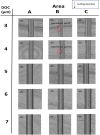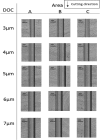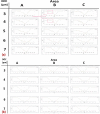Control of the ductile and brittle behavior of titanium alloys in diamond cutting by applying a magnetic field
- PMID: 30858486
- PMCID: PMC6411752
- DOI: 10.1038/s41598-019-40702-7
Control of the ductile and brittle behavior of titanium alloys in diamond cutting by applying a magnetic field
Abstract
As a result of extensive investigations into deformation mechanisms of titanium alloys, it has been found that ductile and brittle behavior occurs during diamond cutting of the alloys. Other than implementing ductile regime machining for improving machining performances, in this study, an application of magnetic field in diamond cutting is proposed to enhance the machining performances in both ductile and brittle deformations in diamond cutting of titanium alloys. Results from the experiments showed that under the influence of a magnetic field, the cutting heat at the tool/titanium interface decreased, and surface damages induced from the brittle deformation were remarkably suppressed. The surface quality of both ductile and brittle deformation areas was enhanced in a presence of the magnetic field, which the surface profiles were less distortive with fewer cracks and defects in brittle deformation regions, and the cutting forces at the transition point became less fluctuant and much smoother. This study contributes enhancements of machining performances in ductile and brittle machining in diamond cutting of titanium alloys, increasing the precise level of machined components made with titanium alloys.
Conflict of interest statement
The authors declare no competing interests.
Figures







References
-
- Khorev AI. High-strength titanium alloy VT23 and its applications in advanced welded and brazed structures. Weld. Int. 2010;24:276–281. doi: 10.1080/09507110903319925. - DOI
LinkOut - more resources
Full Text Sources
Research Materials

